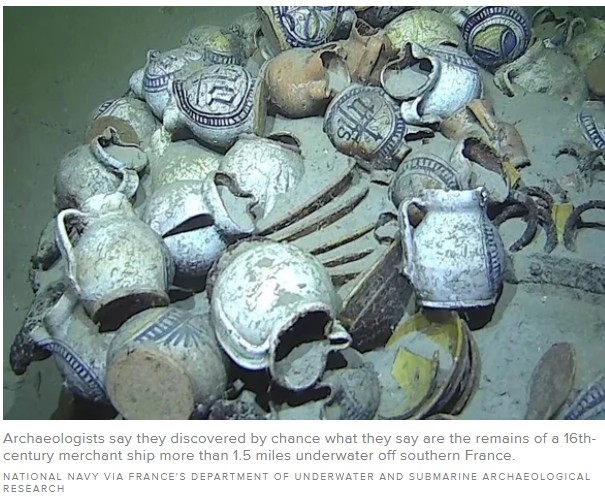Written by the TreasureGuide for the exclusive use of the Treasure Beaches Report.
Archaeologists have discovered by chance what they say are the remains of a 16th-century merchant ship more than 1.5 miles underwater off southern France, the deepest such find in its section of the Mediterranean or any other French waters.
Archaeologists believe the ship was sailing from northern Italy loaded with ceramics and metal bars before it sunk.
Despite a little modern waste dotting its sunken cargo at 8,422 feet below sea level, researchers were excited about the potential of an archaeological site largely preserved intact.
"It's the deepest shipwreck ever found in French territorial waters," Arnaud Schaumasse, the head of the culture ministry's underwater archaeology department, said late Wednesday...
Here is the link for more about that.
---
The article says the shipwreck discovery was made by "chance.". How many times have you made finds by chance?
My first thought was all of them, but that isn't quite true. There are times when we attempt to find a very specific item, such as maybe a recently lost ring and find it. That is all seems very intentional. But even when looking for something very specific, I've often found something completely unexpected and unanticipated. You can definitely say that was by chance. The same can be said all of those things that are found when you go out and search an area not knowing what might be there. When we do our research and improve our skill and technique, we change the balance of skill and chance. As we increase our level of skill, we increase the probability of a find. In fact, I've defined skill as actions intentionally taken that improve the probability of success.
When I was a child and did something that turned out well, my dad would always say "I'd rather be lucky than good." He wasn't one to offer a lot of praise. There wasn't a lot of mollycoddling. They expected you to be tough. They didn't want you to get a big head. That isn't the way it is done today, but it seemed to work out ok. I suppose the fellows coming back alive from World War II realized it had a lot more to do with luck than anything they did, and they knew that many of their buddies that did not survive were among the finest.
There are times when after a day on the beach people will ask you if you had any luck, and there are times when you feel either lucky or not. We might not think about it much or take it too seriously, but we sometimes feel lucky - or not.
One definition of luck says that luck refers to improbable events, especially improbably positive or negative ones. The naturalistic interpretation is that positive and negative events may happen at any time, both due to random and non-random natural and artificial processes, and that even improbable events can happen by random chance. In this view, the epithet "lucky" or "unlucky" is a descriptive label that refers to an event's positivity, negativity, or improbability.Supernatural interpretations of luck consider it to be an attribute of a person or object, or the result of a favorable or unfavorable view of a deity upon a person.
Below is a little chart I made. The vertical axis shows the frequency of different types of finds, going from common inexpensive finds at the top to less common and higher value finds at the bottom. The horizontal axis shows the value of different types of finds, going from one cent on the left to $100,000 on the right.
To the left of the curved line is worthless junk.
The line starts high on the left because very low value targets are very common and very frequently found. Hunting like most people, you'll find many pennies, nickels, dimes, etc. and not as many gold items.
As the value increases (line going from left to right) the frequency they are found generally decreases (line goes from high to low).
Just to the right of the beginning of the downward sloping line there is a curve as you get into targets of increasing value such as silver rings, small gold rings, better rings, etc.
Silver rings and gold bands fall largely in this big curve area. They are less common than coins, but more common than more valuable finds.
The line gets pretty flat way out to the right. There is not much difference in the probability of finding a $30,000 ring or a $40,000 ring. That is why the line gets flat. The frequency (or probability) does not decrease much at the very high level. They are all fairly rare at that level. How rare depends to some extent on where you hunt.
Lets say you find a gold band weighing one tenth of a troy oz. That is not the smallest you could find but it is way smaller than the heaviest you could find. I would say it is not an uncommon weight. You might get $60 or more for one tenth of an oz. of 14K gold at today's prices. A ring like that would be worth something like 800 clad coin finds.
Of course you could find a ring weighing a full oz. or more, or it might have good quality diamonds, taking you up in the tens of thousands of dollars.
Low value targets are very common, but it seemingly takes forever for the value to accumulate to anything very significant. Therefore, when deciding what you want to target you might want to make a calculated decision about where and how you want to hunt. Maybe an area that produces fewer coins but more high value targets would be worthwhile


